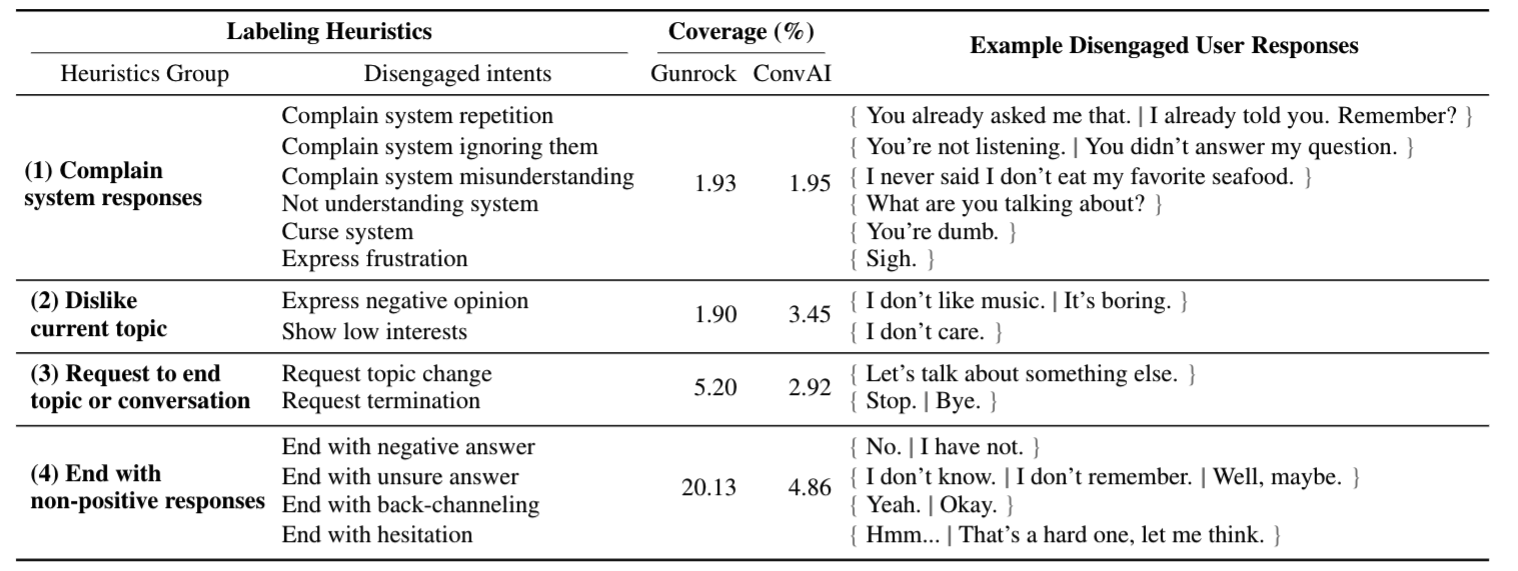This repo provides the PyTorch source code of our paper: HERALD: An Annotation Efficient Method to Train User Engagement Predictors in Dialogs (ACL 2021). [PDF] [Video: Prof. Zhou Yu]
@inproceedings{liang2021herald,
author = {Weixin Liang and Kai-Hui Liang and Zhou Yu},
title = {{HERALD:} An Annotation Efficient Method to Train User Engagement Predictors in Dialogs},
year = {2021},
booktitle = {{ACL}},
publisher = {Association for Computational Linguistics}
}
Open-domain dialog systems have a user-centric goal: to provide humans with an engaging conversation experience. User engagement is one of the most important metrics for evaluating open-domain dialog systems, and could also be used as real-time feedback to benefit dialog policy learning. Existing work on detecting user disengagement typically requires hand-labeling many dialog samples. We propose HERALD, an annotation efficient framework that reframes the training data annotation process as a denoising problem. Specifically, instead of manually labeling training samples, we first use a set of labeling heuristics to automatically label training samples. We then denoise the weakly labeled data using Shapley algorithm. Finally, we use the denoised data to train a user engagement detector. Our experiments show that HERALD improves annotation efficiency significantly and achieves 86% user disengagement detection accuracy in two dialog corpora. Our implementation is available at https://github.com/Weixin-Liang/HERALD/
 Table: Our labeling heuristics designed to capture user disengagement in dialogs. A dialog turn is considereddisengaged if any of the heuristic rules applies to the user responses.
Table: Our labeling heuristics designed to capture user disengagement in dialogs. A dialog turn is considereddisengaged if any of the heuristic rules applies to the user responses.
Run the following commands to create a conda environment (assuming CUDA10.1):
conda create -n herald python=3.6
conda activate herald
conda install pytorch torchvision torchaudio cudatoolkit=10.2 -c pytorch
conda install matplotlib scipy
conda install -c conda-forge scikit-learn
conda install -c conda-forge transformers
conda install pandasPlease check shapley/requirements.txt or shapley/requirements.yml for additional details about the dependencies (Note that you don't need to install all of them).
Please check shapley/bert_dialog_engagement_classifier.py and shapley/data_utils.py. The code is built upon the github repo ABSA-PyTorch. Many thanks to the authors and developers!
python bert_dialog_engagement_classifier.py --model_name bert_spcPlease check shapley/convai_data/convai_dataloader.py for supporting custom dialog dataset.
Shapley algorithm computes a Shapley value for each training datum, which quantifies the contribution of each training datum to the prediction and performance of a deep network. Low Shapley value data capture outliers and corruptions. Therefore, we can identify and denoise the incorrectly-labeled data by computing their Shapley values, and then fine-tune the model on cleaned training set.
To obtain a closed-form solution of Shapley value, we extract the features of training data points and apply a K-nearest-neighbour classifier. The Shapley value of each training point can be calculated recursively as follows:
Please check shapley/shapley.py for the implementation of the shapley algorithm. Note that you need to first extract the features for training datapoints before running the K-nearest-neighbour based Shapley algorithm. In particular, the core function for calculating the single point data shapley value is:
def single_point_shapley(xt_query, y_tdev_label):
distance1 = np.sum(np.square(X-xt_query), axis=1)
alpha = np.argsort(distance1)
shapley_arr = np.zeros(N)
for i in range(N-1, -1, -1):
if i == N-1:
shapley_arr[alpha[i]] = int(y[alpha[i]] == y_tdev_label) /N
else:
shapley_arr[alpha[i]] = shapley_arr[alpha[i+1]] + \
( int(y[alpha[i]]==y_tdev_label) - int(y[alpha[i+1]]==y_tdev_label) )/K * min(K,i+1)/(i+1)
return shapley_arrHere we use (i+1) since i starts from zero in our python implementaion.
Beyond User Self-Reported Likert Scale Ratings: A Comparison Model for Automatic Dialog Evaluation (ACL 2020). Weixin Liang, James Zou and Zhou Yu. [PDF] [Video] [Stanford AI Lab Blog] [Slides] [Code]
Data Shapley: Equitable Data Valuation for Machine Learning. (ICML 2019). Amirata Ghorbani, James Zou. [PDF] [Video] [Poster] [Slides] [Code]
Thank you for your interest in our work! Please contact us at kl3312@columbia.edu, wxliang@stanford.edu for any questions, comments, or suggestions!





